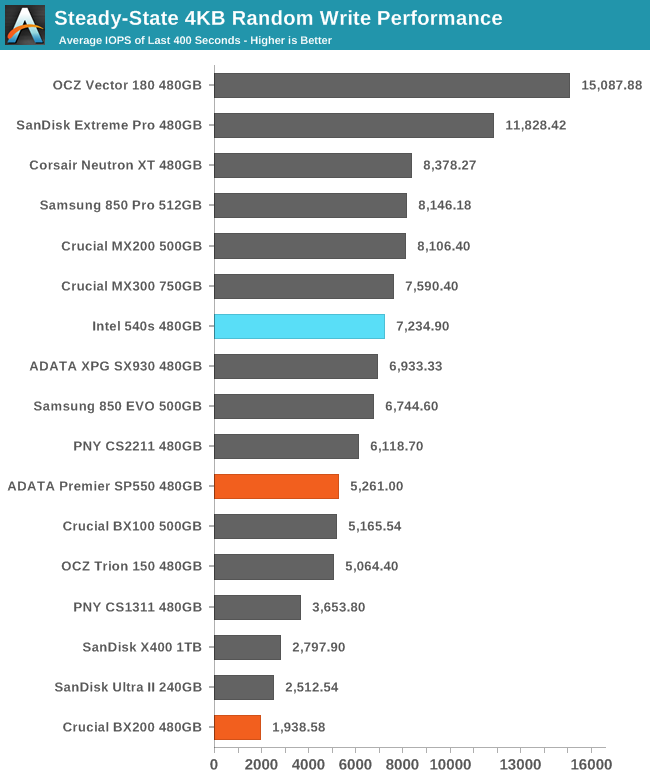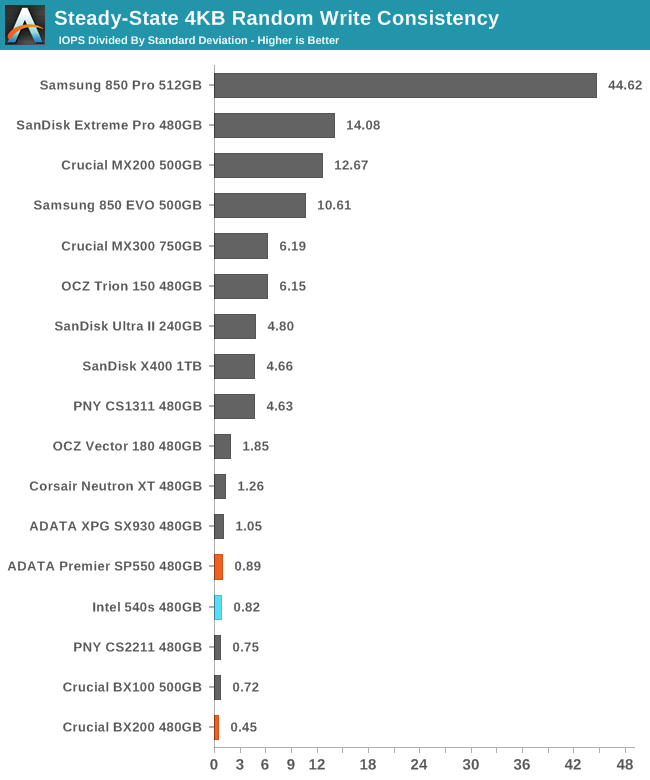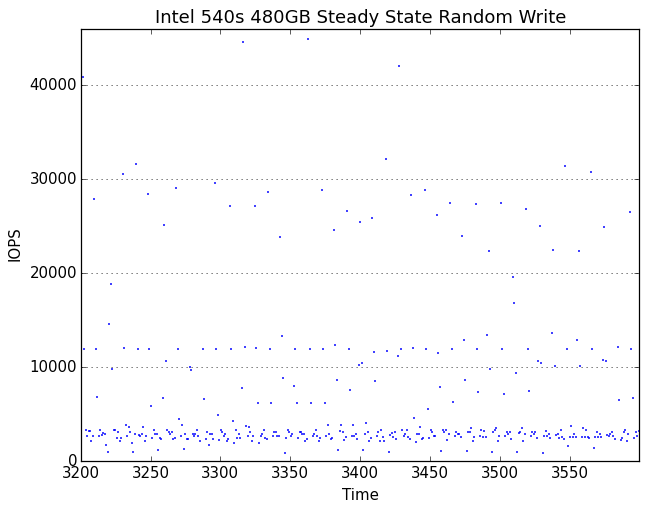The Intel SSD 540s (480GB) Review
by Billy Tallis on June 23, 2016 9:00 AM ESTPerformance Consistency
Our performance consistency test explores the extent to which a drive can reliably sustain performance during a long-duration random write test. Specifications for consumer drives typically list peak performance numbers only attainable in ideal conditions. The performance in a worst-case scenario can be drastically different as over the course of a long test drives can run out of spare area, have to start performing garbage collection, and sometimes even reach power or thermal limits.
In addition to an overall decline in performance, a long test can show patterns in how performance varies on shorter timescales. Some drives will exhibit very little variance in performance from second to second, while others will show massive drops in performance during each garbage collection cycle but otherwise maintain good performance, and others show constantly wide variance. If a drive periodically slows to hard drive levels of performance, it may feel slow to use even if its overall average performance is very high.
To maximally stress the drive's controller and force it to perform garbage collection and wear leveling, this test conducts 4kB random writes with a queue depth of 32. The drive is filled before the start of the test, and the test duration is one hour. Any spare area will be exhausted early in the test and by the end of the hour even the largest drives with the most overprovisioning will have reached a steady state. We use the last 400 seconds of the test to score the drive both on steady-state average writes per second and on its performance divided by the standard deviation.

Right from the start we see a substantial improvement of the SM2258 over SM2256, as steady-state random write speed has increased by 37%. This puts the Intel 540s well ahead of any other planar TLC drive and ahead of a few low-end MLC drives as well.

While the average random write speed has improved, the consistency is a bit worse and the Intel 540s scores in the bottom tier of drives. Phison's most recent generation of TLC drives managed to deliver very consistent steady state performance, but Silicon Motion still has a lot of room for improvement here.
 |
|||||||||
| Default | |||||||||
| 25% Over-Provisioning | |||||||||
The consistency of the 540s was clearly poor even before the transition to steady state, but during that early phase of the test it delivered twice the IOPS of the ADATA SP550.
 |
|||||||||
| Default | |||||||||
| 25% Over-Provisioning | |||||||||
Once in steady state, the 540s performance mostly stays slightly above the SP550. Both drives have frequent outliers beyond their band of usual performance, and the outliers are almost all in the direction of better performance. The Intel drive's outliers hit some much higher peaks than the ADATA SP550, suggesting that the new SM2258 controller may have significantly improved performance on bursty workloads.










77 Comments
View All Comments
Notmyusualid - Thursday, June 23, 2016 - link
Ya saved me from writing it...shelbystripes - Thursday, June 23, 2016 - link
Intel is considered a reliable brand to OEM PC makers and other bulk purchasers. Offering a low-end part means capturing business that might go to a second-tier manufacturer. For builders with a use case where any modern SSD is fast enough, and you care about reliability without breaking the bank, this will be the #1 choice. You get the Intel name and the things INCLUDED with that, like solid customer support and timely firmware updates, at a lower price point.Nobody buying this is expecting it to be a performance part. Intel is the company that sold Celerons with no L2 cache, that sells cut-down Atom CPUs and Core CPUs under the same Pentium brand name. Intel doesn't always mean performance. It does mean confidence that what you're buying actually works, though.
BurntMyBacon - Friday, June 24, 2016 - link
@shelbystripes: "Offering a low-end part means capturing business that might go to a second-tier manufacturer. For builders with a use case where any modern SSD is fast enough, and you care about reliability without breaking the bank, this will be the #1 choice."You know, Intel used to cater to this market, ... , with their 300 series drives. Interestingly, the relative performance of this drive matches up to where their 300 series used to slot in as well. Why is this not a 300 series drive?
vladx - Friday, June 24, 2016 - link
My tablet running an Atom quad-core works great. To compare this joke of a SSD from Intel to that is a fucking joke.plopke - Thursday, June 23, 2016 - link
Won't the 540 be shortlived? Shouldn't we be seeing 3d nand drives of intel soon followed by optane?https://i0.wp.com/benchlife.info/wp-content/upload...
A5 - Thursday, June 23, 2016 - link
This is for a different market segment.Billy Tallis - Thursday, June 23, 2016 - link
That roadmap shows the 540s sticking around at least through Q1 2017, and merely being joined by some Optane and 3D TLC NVMe drives. The actual replacement of the 540s is at an indefinite point in the future.The determining factor will be how long it takes 3D NAND to get cheap enough to displace 15/16nm TLC. I don't think that will be happening any time soon; even Samsung apparently can't pull it off yet, since they introduced the 750 EVO.
Mobile-Dom - Thursday, June 23, 2016 - link
IIRC Samsung used planar NAND in the 750 because they wanted lower capacity without the performance degradation, as by using the high layered 3D NAND they used fewer packages resulting in worse performance for drives that had 1 or 2 packages for the entire SSDextide - Thursday, June 23, 2016 - link
Nah, both their planar 15/16nm and their 3D NAND use 128Gb dies -- so same amount of dies in either product. It's purely a cost thing. It will probably take until we get into the 100+ layers of 3D NAND for it to be competitive, cost wise, with that 15/16nm planar TLC.Billy Tallis - Thursday, June 23, 2016 - link
That's what they said at first, but then they introduced a 500GB 750 EVO while the 850 EVOs on the market are still using the 32-layer VNAND.